Visual Storytelling: Engaging Fashion Audiences Online

Understanding Visual Storytelling in Fashion
Visual storytelling is the art of using images, videos, and graphics to convey a narrative. In the fashion industry, where aesthetics are paramount, this technique can transform how brands connect with their audience. By weaving a story through visuals, brands not only showcase their products but also communicate their values and identity.
The best stories are those that are true to who we are, and that resonate with the values we hold dear.
Think of visual storytelling as creating a mood board that reflects the essence of a brand. For instance, a luxury fashion label might use stunning imagery of its clothing in elegant settings to evoke feelings of sophistication. This approach not only highlights the products but also builds an emotional connection with potential customers, making them more likely to engage.
Furthermore, effective visual storytelling can help brands stand out in a crowded marketplace. With consumers bombarded by countless choices, a compelling visual narrative can capture attention and keep audiences invested in a brand’s journey.
The Importance of Authenticity in Fashion Narratives
In today's digital world, authenticity is key to resonating with fashion audiences. Consumers are increasingly looking for brands that reflect their values and lifestyle. By presenting genuine stories behind the products, brands can foster trust and loyalty among their followers.

For example, a brand that shares the story of its sustainable practices or the artisans behind its collections creates a deeper connection with its audience. This transparency not only enhances the brand's image but also encourages consumers to feel like they are part of something bigger.
Visual Storytelling Enhances Connection
Using visuals effectively allows fashion brands to convey narratives that resonate emotionally with their audience.
Moreover, authenticity can differentiate a brand from its competitors. When a fashion label embraces its unique story—whether it's rooted in heritage, innovation, or community—it allows consumers to relate on a personal level, making them more likely to support the brand.
Utilizing Social Media for Visual Storytelling
Social media platforms like Instagram, TikTok, and Pinterest are perfect arenas for visual storytelling in fashion. These platforms prioritize visual content, allowing brands to showcase their products through captivating images and videos. Engaging posts, stories, and reels can create a dynamic narrative that keeps audiences coming back for more.
In a world where you can be anything, be authentic.
For instance, behind-the-scenes content, styling tips, or customer testimonials can enhance the brand's story. By using features like Instagram Stories, brands can share real-time updates that bring their audience along for the journey. This immediacy fosters a sense of community and encourages interaction.
Additionally, leveraging user-generated content can amplify a brand's narrative. When customers share their own experiences with a product, it adds an authentic layer to the brand's story and encourages others to engage and share as well.
Visual Consistency: Building Brand Identity
Consistency in visual storytelling is vital for establishing a strong brand identity. By maintaining a cohesive aesthetic across all platforms, brands can create a recognizable image that resonates with their audience. This includes color schemes, typography, and overall style that aligns with the brand's message.
For example, if a fashion brand is known for its vibrant, playful designs, its visual content should reflect that energy. This consistency not only helps in brand recognition but also builds a sense of reliability among consumers. They come to expect a certain vibe, making it easier to connect with the brand.
Authenticity Builds Trust in Fashion
When brands share genuine stories that reflect their values, they foster trust and loyalty among consumers.
Furthermore, this visual harmony can enhance the overall customer experience. When audiences see a unified visual language, they feel more confident in their choice to engage with the brand, leading to increased brand loyalty.
Storytelling Through Fashion Campaigns
Fashion campaigns are an excellent opportunity to employ visual storytelling effectively. A well-crafted campaign can convey a compelling narrative that captivates the audience while promoting the brand's latest collections. By focusing on a specific theme or story, brands can create a more immersive experience for their consumers.
For instance, a seasonal campaign might tell the story of a journey through different landscapes, showcasing how the clothing fits into various environments. This not only highlights the versatility of the products but also invites consumers to imagine themselves in those scenarios.
Moreover, incorporating storytelling elements in campaigns can lead to greater engagement. When audiences feel emotionally connected to a campaign's narrative, they are more likely to share it and participate in the conversation, amplifying the brand's reach.
The Role of Video in Fashion Storytelling
Video content is a powerful tool in visual storytelling, especially in the fashion industry. It allows brands to convey complex narratives and emotions in a way that static images often can't. From runway shows to styling tutorials, video content can bring a brand's story to life, engaging viewers on a deeper level.
For example, a behind-the-scenes video of a fashion shoot can provide insight into the creative process, making the audience feel like they are part of the experience. This transparency not only builds excitement but also encourages viewers to invest in the brand's journey.
Social Media Boosts Brand Engagement
Platforms like Instagram and TikTok provide unique opportunities for brands to share captivating visual stories and engage their audience.
Additionally, platforms like YouTube and TikTok offer unique opportunities for brands to connect with their audience. Short, engaging videos can quickly capture attention and convey essential messages, making them an essential part of any fashion storytelling strategy.
Measuring the Impact of Visual Storytelling
To ensure the effectiveness of visual storytelling, brands must measure its impact. Analyzing engagement metrics such as likes, shares, comments, and conversion rates can provide valuable insights into how well a story resonates with the audience. This data can guide future content strategies and help brands refine their approach.
For example, if a particular campaign generates significant buzz, it might indicate that the story aligned well with audience interests. On the other hand, low engagement may signal a need for a different narrative or approach. By staying attuned to audience reactions, brands can adapt and evolve their storytelling efforts.

Moreover, utilizing feedback from customers can enhance storytelling strategies. Encouraging audiences to share their thoughts and experiences not only fosters a sense of community but also provides brands with fresh perspectives on their narratives.